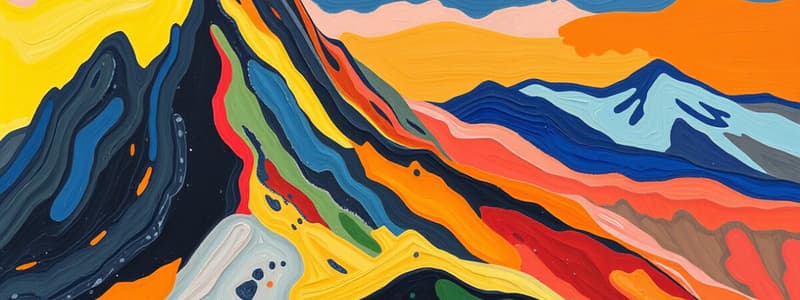Podcast
Questions and Answers
What is the definition of orogenesis?
What is the definition of orogenesis?
Processes that collectively form a mountain belt
According to the plate tectonics model, most global mountain ranges are associated with which kind of plate boundary?
According to the plate tectonics model, most global mountain ranges are associated with which kind of plate boundary?
- Divergent
- Transform
- Convergent (correct)
- None of the above
Which orogeny is largely responsible for creating the modern Rocky Mountains?
Which orogeny is largely responsible for creating the modern Rocky Mountains?
Laramide orogeny
________ contain large quantities of preexisting sedimentary and crystalline rocks that have been faulted and contorted into a series of folds.
________ contain large quantities of preexisting sedimentary and crystalline rocks that have been faulted and contorted into a series of folds.
Which of the following regions of a subduction zone are characterized by thick sequences of relatively undeformed sedimentary rocks?
Which of the following regions of a subduction zone are characterized by thick sequences of relatively undeformed sedimentary rocks?
Which type of volcanic material will dominate the eruptions along a continental volcanic arc?
Which type of volcanic material will dominate the eruptions along a continental volcanic arc?
How would the angle of subduction of a tectonic plate influence the location of a volcanic arc?
How would the angle of subduction of a tectonic plate influence the location of a volcanic arc?
How will isostasy affect the crust as erosion wears down a mountain range with peaks as high as 14,000 feet above sea level?
How will isostasy affect the crust as erosion wears down a mountain range with peaks as high as 14,000 feet above sea level?
Which of the following terms describes the increasing downward force on basal rocks as a mountain continues to grow?
Which of the following terms describes the increasing downward force on basal rocks as a mountain continues to grow?
Which of the following best describes the effect of convective flow on the elevation of Earth's major landforms?
Which of the following best describes the effect of convective flow on the elevation of Earth's major landforms?
What are fault-block mountains?
What are fault-block mountains?
Which of the following best explains why some fault-block mountains have an elevated topography?
Which of the following best explains why some fault-block mountains have an elevated topography?
Which style of convergent boundary will characterize an Andean-type mountain building event?
Which style of convergent boundary will characterize an Andean-type mountain building event?
How can subduction result in the emplacement of batholiths?
How can subduction result in the emplacement of batholiths?
Which of the following locations is a remnant of a forearc basin?
Which of the following locations is a remnant of a forearc basin?
A ________ is a crustal fragment that has been transported by plate tectonics and has adhered to an overriding plate.
A ________ is a crustal fragment that has been transported by plate tectonics and has adhered to an overriding plate.
Which of the following locations is composed largely of accreted terranes?
Which of the following locations is composed largely of accreted terranes?
Which mountain range consists of the youngest collisional mountains on Earth?
Which mountain range consists of the youngest collisional mountains on Earth?
Which of the following statements best characterizes the Valley and Ridge Province of the Appalachian Mountains?
Which of the following statements best characterizes the Valley and Ridge Province of the Appalachian Mountains?
Which of the following statements best characterizes the geology of the Pacific coastal regions of western North America up into Alaska?
Which of the following statements best characterizes the geology of the Pacific coastal regions of western North America up into Alaska?
Flashcards are hidden until you start studying
Study Notes
Orogenesis and Mountain Formation
- Orogenesis refers to processes forming mountain belts.
- Most global mountain ranges are linked to convergent plate boundaries.
- The Laramide orogeny is primarily responsible for the formation of the modern Rocky Mountains.
Mountain Types and Characteristics
- Compressional mountains feature preexisting sedimentary and crystalline rocks that are folded and faulted.
- The forearc region of a subduction zone contains thick sequences of relatively undeformed sedimentary rocks.
- Fault-block mountains are created through crustal extension and may have elevated topography due to lithosphere stretching and thinning.
Volcanic Activity and Subduction Zones
- Continental volcanic arcs primarily produce andesitic lavas and pyroclastic materials.
- The angle of subduction influences volcanic arc location; a steeper angle results in the arc forming closer to the trench.
- Subduction can lead to the formation of batholiths through partial melting of the subducting plate, generating magma.
Isostasy and Erosion
- As mountains erode over time, isostasy causes the mountain range to rebound, affecting the crust's elevation.
Gravity and Geological Processes
- Gravitational collapse describes the increasing downward force on basal rocks as mountains grow.
- Convective flow impacts landform elevation; rising hot material causes upward deformation, while downward flow leads to downwarping.
Terranes and Accretion
- A terrane is a crustal fragment transported by plate tectonics and attaches to an overriding plate.
- California largely consists of accreted terranes, geological fragments that have merged with continental material.
Mountain Ranges and Geological Features
- The Himalayas are noted as the youngest collisional mountain range on Earth.
- The Valley and Ridge Province of the Appalachian Mountains is characterized by folded sedimentary strata from the late Paleozoic Era.
- The Pacific coastal regions of western North America, extending into Alaska, feature distinct geological fragments and accreted terraces.
Studying That Suits You
Use AI to generate personalized quizzes and flashcards to suit your learning preferences.




